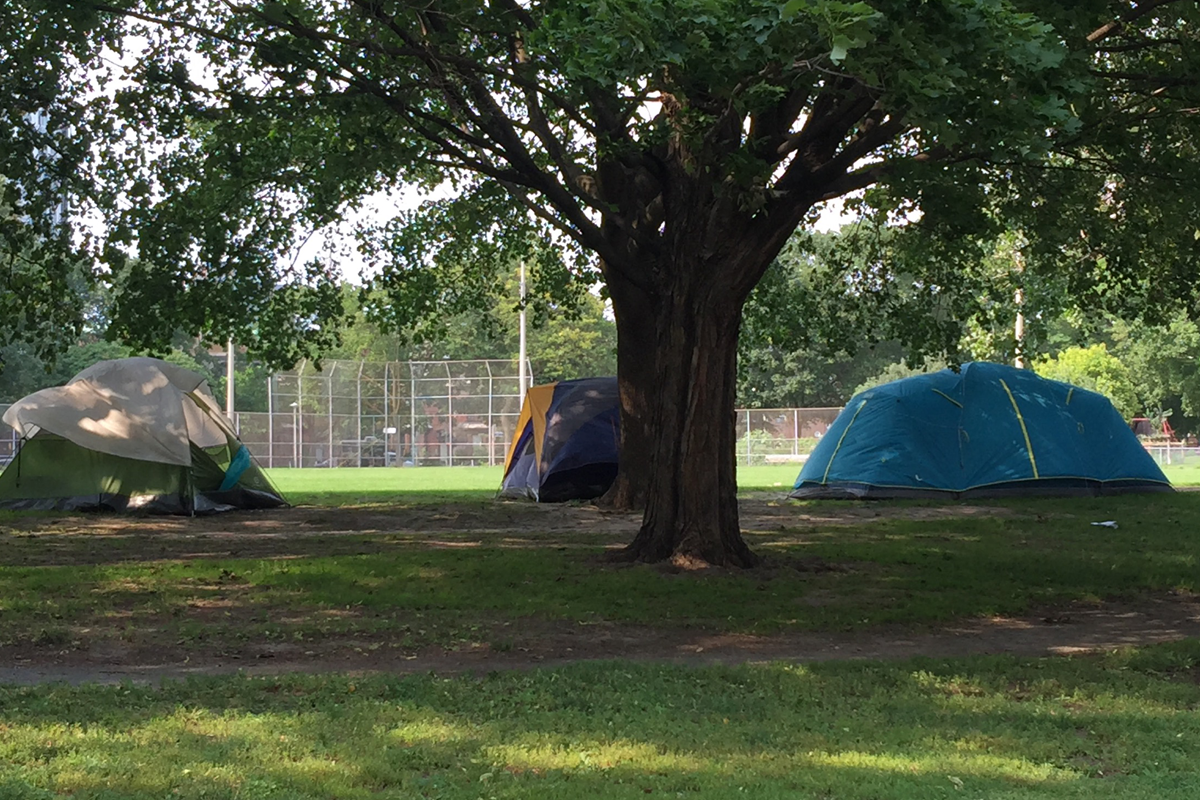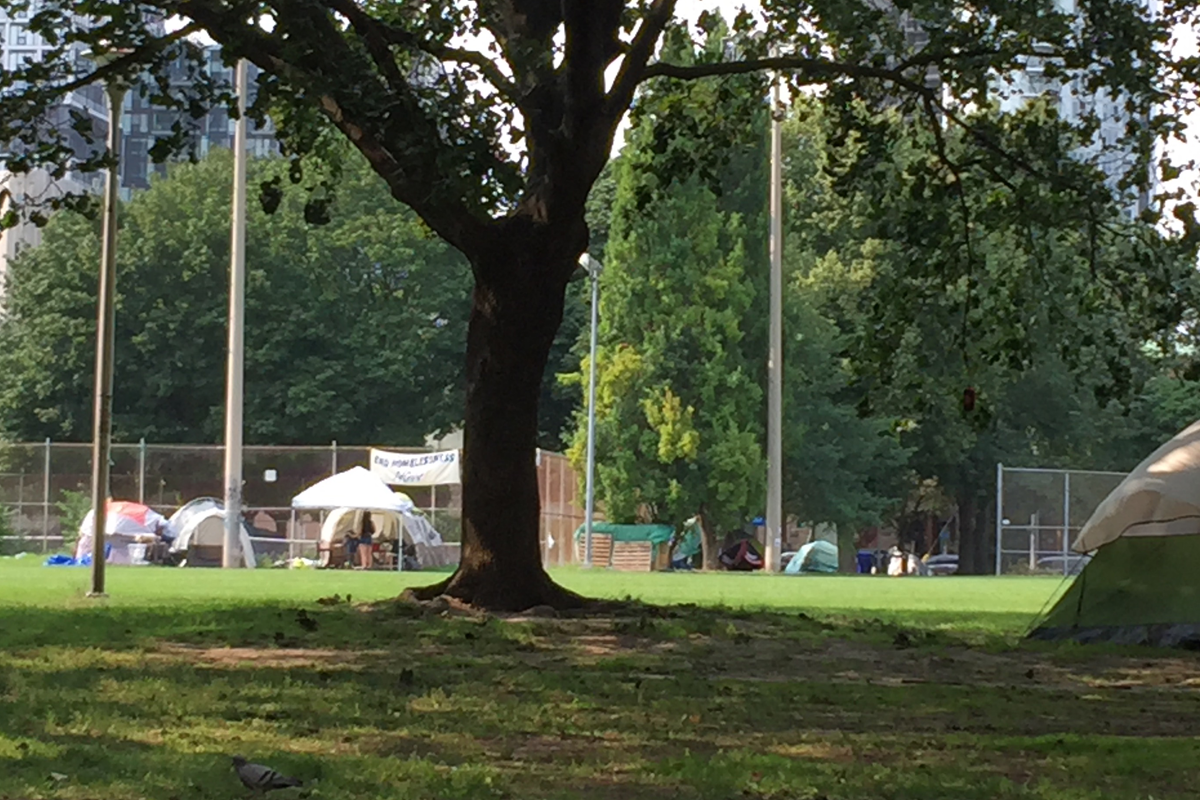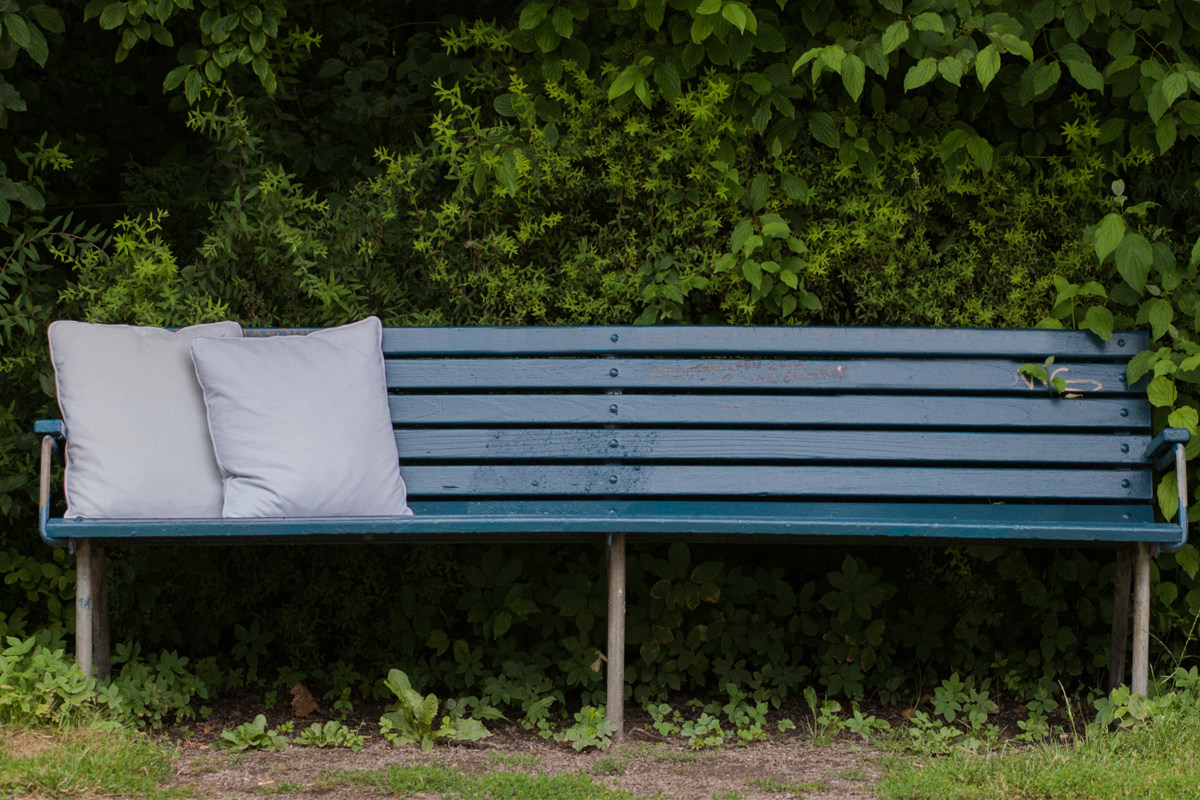
04 Aug Addressing Homelessness in Parks: Towards A Human Rights Approach
Insights from the 8 80 Cities Team
Creating public spaces that are safe, comfortable, and welcoming for people of all ages, abilities, incomes, and social identities is at the core of what we do at 8 80 Cities. The pandemic has highlighted that our parks are essential places for individual and community health and wellbeing. Predominant societal attitudes, policies, and practices often criminalize and stigmatize people experiencing homelessness. As members of the public and human beings, people experiencing homelessness have a right to safe, comfortable public spaces that can support their everyday dignity, safety, and wellbeing.
How we plan, design, and manage our parks and public spaces directly reflects our values and priorities as a city. Investing in great parks and public spaces cannot solve the issue of chronic homelessness. But cities, like our own home city of Toronto, can do more to leverage the power of parks and public spaces as platforms for achieving healthy and equitable outcomes for all users, including people experiencing homelessness.
Homelessness materializes in parks and public spaces due to several failures in public policy. Racist housing and planning policies that disproportionately discriminate against Black, Indigenous, and People of Colour (BIPOC) including Redlining in Canada have had wide-ranging effects on who has and has not benefited from homeownership and the right to safe, adequate and affordable housing in this country. For Indigenous people in Canada, colonization and the effects of intergenerational trauma have shaped their experiences with housing insecurity and homelessness. The fight for safe, adequate housing has been a longstanding issue tied to deep-rooted structures that marginalize Indigenous people. The Native Women’s Association of Canada Report on Housing highlights the impact of housing challenges on Indigenous women, girls, and gender-diverse people is rooted in colonial oppression and through gender-based discrimination inherent in these structures.
People living with disabilities are also at a higher risk of experiencing homelessness and face additional barriers to housing and employment and are more likely to be living in poverty.
An overall lack of affordable housing, unsafe shelter systems or quality alternatives, a lack of services and support, and systemic barriers to employment have contributed to a housing crisis that, amidst the pandemic, has become more visible.
While investing in affordable housing and social supports is one of the most important things communities can do to address homelessness, there are also important approaches advocates, planners, parks managers, and policymakers can take to better address the issue of homelessness in parks.
Over the past year and a half, we have conducted research with subject matter experts, researchers, park managers, and frontline support workers. We would like to share what we have learned to inform more inclusive park management approaches for cities going forward.

A call to action for cities and communities on better addressing homelessness in parks:
ADOPTING A HUMAN RIGHTS + TRAUMA-INFORMED APPROACH
Adopting a human rights approach to parks management emphasizes the right of people experiencing homelessness to exist in public spaces and to have their basic needs met. A human rights approach seeks to hold all levels of government accountable for the health and wellbeing of people experiencing homelessness. The displacement and forced removal of people experiencing homelessness from parks and public spaces contradicts the United Nations’ Special Report on the Right to Adequate Housing and should not be a policy in any community.
Adopting a trauma-informed care approach is about acknowledging that people experiencing homelessness are more likely to have experienced trauma. People working in parks management should be trained on trauma-informed approaches that focus on creating environments of healing and recovery, compassionate mental health support while simultaneously working towards creating an organizational culture of understanding, respect, and appropriate responses to the effects of trauma. Removing tents and the belongings of a person experiencing homelessness can compound trauma and does little to build spaces of compassion and trust that the public realm should embody.
Stigma and bias are intrinsically linked to the ways in which people experiencing homelessness are mistreated and portrayed in policy. Stigma and bias about substance use, mental health, and poverty move responsibility from municipal leaders and the overarching exclusionary and unjust systems currently in place.
COMPASSIONATE ALTERNATIVES TO ENFORCEMENT
The razing of homeless encampments, known as ‘sweeps,’ is violent and cruel yet is still the most common ‘solution’ cities pursue to address homelessness in parks. The recent recurring tactics used by police at Lamport Stadium, Alexandra Park, and Trinity Bellwoods Park in Toronto, where clearing of encampments resulted in violence and further harm underscores the lack of understanding and cluelessness about the impact these actions have on people. These actions only perpetuate trauma and further distrust from people experiencing homelessness. BIPOC (Black, Indigenous, People of Colour) and gender-diverse individuals and families are more likely to experience over-policing in parks and public spaces. Policing and enforcement will not take someone out of homelessness; compassion, social services support, and housing will. Innovative approaches and alternatives are needed where support and outreach are based on empathy, trust-building, and inclusive engagement rather than punishment and displacement.
A network of wrap-around supports with trained social workers is needed to address the diverse needs of individuals experiencing homelessness. Parks and recreation departments, social service agencies, and housing authorities need to work together to integrate their response and allocate resources to serve the needs of people experiencing homelessness. A more proactive approach to addressing homelessness involves developing partnerships with non-profits, private groups, and religious affiliate groups to connect people experiencing homelessness to the services they need. An example recently highlighted in this Globe and Mail article describes the City of Seattle’s JustCARE model program, which has worked to eliminate encampments without displacement or the use of police by focusing efforts instead on coordinated support services. Local governments can increase investment in trained street outreach teams to amplify access to programs for people experiencing homelessness.
FOCUS ON BUILDING TRUST & RELATIONSHIPS
People experiencing homelessness have been systematically failed by their institutions and lack familial support. This understanding needs to inform how social services design their outreach and service provision. Social services can perpetuate broken trust, and shelters can create barriers and restrictions for access, which has often fueled the retreat to parks and public spaces by people experiencing homelessness. Broken relationships and trust with institutions among racialized populations are even more pervasive, given that many were built upon racist ideas and principles. Culturally relevant services, cultural representation in frontline staff, and cultural competency and training are particularly important when working with equity-seeking groups, including Black, Indigenous, and People of Color (BIPOC). Building back trust and creating meaningful relationships on the ground with those experiencing homelessness is key to moving forward. However, this requires patience and time. Engaging people experiencing homelessness can take weeks, months, or even years. Pride, mental health, addiction, trauma, and broken trust can prevent people from asking for help. Deadlines for forced removal can immediately erase any trust that may have been established with frontline workers and social service providers.

DESIGN FOR DIGNITY
Parks and public spaces featuring hostile architecture seek to control or repel certain groups of people from using that space. Such hostility can be seen in anti-homeless designed benches where it is impossible to lay down. Other such hostile interventions include a lack of public washrooms year-round in public spaces for the fear that people experiencing homelessness will use them to warm themselves and therefore stay longer in parks and public spaces. Hostile architecture revolves around creating uncomfortable spaces for people who are perceived as undesirable.
Designing for dignity is the recognition that people experiencing homelessness will always use or inhabit parks and public spaces, and hostile design will never dissuade use or assist in addressing the root causes of homelessness. Designing parks and public spaces for dignity does not need to rely on large capital investments but can be done by adding a touchpoint to access services. While providing services will not remedy homelessness, creating a low barrier way to engage in outreach with people experiencing homelessness is crucial to creating a park for all users. Part of designing for dignity is to acknowledge the human needs of all park residents by introducing a year-round washroom, water fountains, hand washing, and sanitation facilities. Signage and bylaws that “close” the parks at certain times of night, along with “no loitering” signs in parks are exclusive and discriminatory toward people experiencing homelessness. Remove hostile architecture and amend or replace such elements with infrastructure that supports safe and comfortable staying activity for all users. Hostile architecture includes benches with designs that prevent laying down, spikes on curbs and corners to prevent camping and panhandling, and strategically placed bollards and boulders to prevent the erection of tents.
City leaders and policymakers should not accept homelessness as inevitable. Cities like Helsinki, Finland have proven that homelessness can be eliminated with policies that focus on providing homes first (Housing First) coupled with social support. In this recent article, research shows this Housing First model is also working in Denver, Colorado. Creating inclusive parks and public spaces cannot be decoupled with housing justice. If you advocate for safe “parks for all,” you must also advocate for and invest in housing and human rights.



